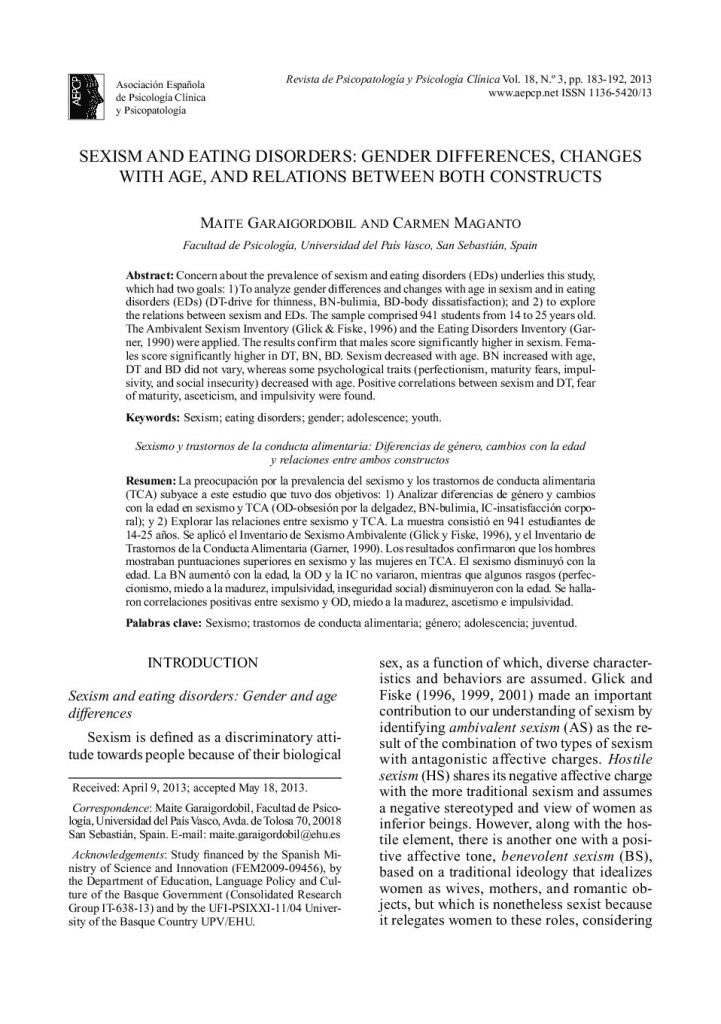Sexism and Eating Disorders: Gender differences, changes with age, and relations between both constructs.

- Hábitos y problemas de sueño en niños con sintomatología depresiva.
- Sexism and Eating Disorders: Gender differences, changes with age, and relations between both constructs.
- Efectos del tipo de diabetes, estrategias de afrontamiento, sexo y optimismo en el apoyo social.
- Training to improve selective attention in children using neurofeedback through play.
- Trastornos leves del espectro autista en educación infantil: Prevalencia, sintomatología co-ocurrente y desarrollo psicosocial.
- Características neuropsicológicas de niños con trastorno negativista desafiante.
- Utilidad de los marcadores biológicos en la detección precoz y prevención del síndrome de burnout.
- DSM-5: ¿Cambio de paradigma en la clasificación de los trastornos mentales?.
- Simons, G. y Hofmann, S. G.(2013). CBT for anxiety disorders: A practitioner book.Chichester (UK): Wiley-Blackwell.
- Geekie, J. y Read, J. (2012). El sentido de la locura. Barcelona: Herder.
- Información sobre criterios de calidad de la Revista de Psicopatología y Psicología Clínica.
Concern about the prevalence of sexism and eating disorders (EDs) underlies this study, which had two goals: 1) To analyze gender differences and changes with age in sexism and in eating disorders (EDs) (DT-drive for thinness, BN-bulimia, BD-body dissatisfaction); and 2) to explore the relations between sexism and EDs. The sample comprised 941 students from 14 to 25 years old. The Ambivalent Sexism Inventory (Glick & Fiske, 1996) and the Eating Disorders Inventory (Garner, 1990) were applied. The results confirm that males score significantly higher in sexism. Females score significantly higher in DT, BN, BD. Sexism decreased with age. BN increased with age, DT and BD did not vary, whereas some psychological traits (perfectionism, maturity fears, impulsivity, and social insecurity) decreased with age. Positive correlations between sexism and DT, fear of maturity, asceticism, and impulsivity were found.
La preocupación por la prevalencia del sexismo y los trastornos de conducta alimentaria (TCA) subyace a este estudio que tuvo dos objetivos: 1) Analizar diferencias de género y cambios con la edad en sexismo y TCA (OD-obsesión por la delgadez, BN-bulimia, IC-insatisfacción corporal); y 2) Explorar las relaciones entre sexismo y TCA. La muestra consistió en 941 estudiantes de 14-25 años. Se aplicó el Inventario de Sexismo Ambivalente (Glick y Fiske, 1996), y el Inventario de Trastornos de la Conducta Alimentaria (Garner, 1990). Los resultados confirmaron que los hombres mostraban puntuaciones superiores en sexismo y las mujeres en TCA. El sexismo disminuyó con la edad. La BN aumentó con la edad, la OD y la IC no variaron, mientras que algunos rasgos (perfeccionismo, miedo a la madurez, impulsividad, inseguridad social) disminuyeron con la edad. Se hallaron correlaciones positivas entre sexismo y OD, miedo a la madurez, ascetismo e impulsividad.



